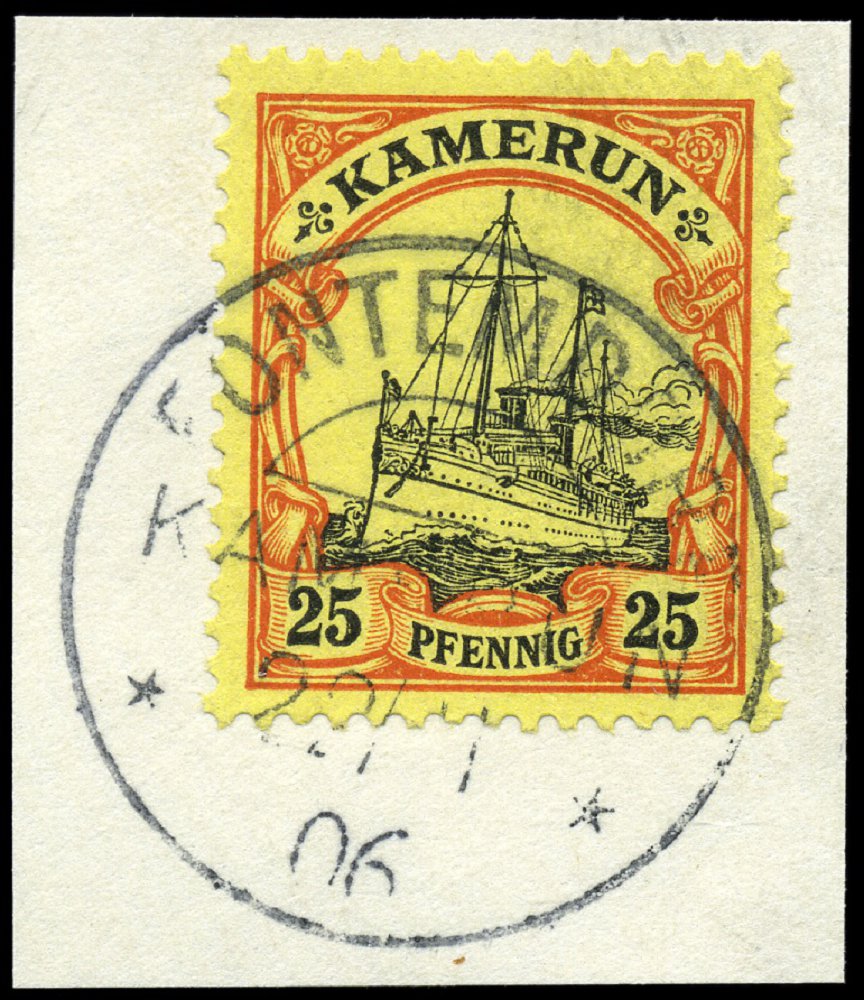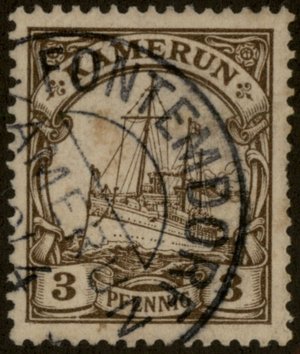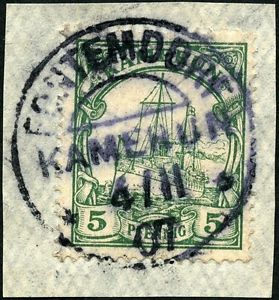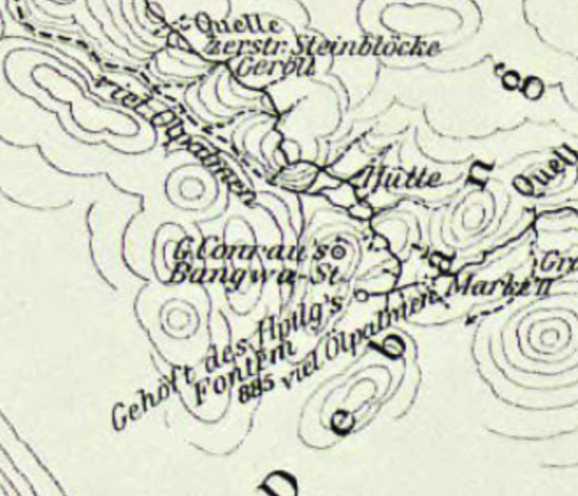Notes on Gustav Conrau and the German Occupation
Vincent Lockhart

Fon - the ruler of one of the Bangwa kingdoms. The Fon is the head of a hierarchy of chiefs, sub-chiefs and nobles.
Lebang - The kingdom of the Fon of Lebang, Fontem Asonganyi. The area has sometimes also been known generically as 'Fontem'.
Azi - The capital of Lebang and the site of the Fon's palace. After taking control, the Germans renamed it 'Fontemdorf'.
Lewoh - The kingdom of Folewoh Achankeng Fotabong, Fon at the time of the German invasion. During both the German and British colonial period the village and area were referred to as Fotabong I.
Takwai - a village in the Bayang tribal area with whom Fontem Asonganyi formed an alliance at various times.
Fossungwenchem - a Bangwa village on the east side of the Bago river which was the sight of two battles between the Germans and the Bangwa.
Tinto - German trading station which later became a military garrison. The garrison was transferred to Fontemdorf and later transferred from there to Dschang.


In 1884 German colonial forces took control of the coastal stretch of Cameroon and appropriated vast tracts of land in order to establish areas for rubber and palm oil production. The immediate consequence for the native population was to have their property confiscated, their villages burned, their chiefs murdered or imprisoned and every adult forced to work unpaid for the German companies running the plantations. They named their new colony 'Kamerun'.
Among their colonial contemporaries the Germans were unrivalled in their systematic cruelty towards the indigenous populations of their colonies (German South-East Africa, German South-West Africa, German Togoland and Kamerun). With death rates among workers soaring into the hundreds on the new Kamerun plantations and a desire to extend their control to the hinterland, expeditions were dispatched northwards to establish bases at places such as Nkongsamba, Kumba, Tinto and Bali.
Gustav Conrau
Part of that strategy was for representatives of the plantation companies to venture inland to secure more workers but they were also tasked with mapping out the country and discovering potential resources. One such agent was the German trader, explorer and collector, Gustav Conrau.
The account of his visits to Azi and what happened after his death are told in the three articles on this website, A Bangwa account of early encounters with the German colonial administration, The Bangwa and the Germans: A Tailpiece and The 1922 Bangwa Tribal Area Assessment Report. What I add here are bits of information I picked up from various sources during my years in Lebialem and which might be of interest.
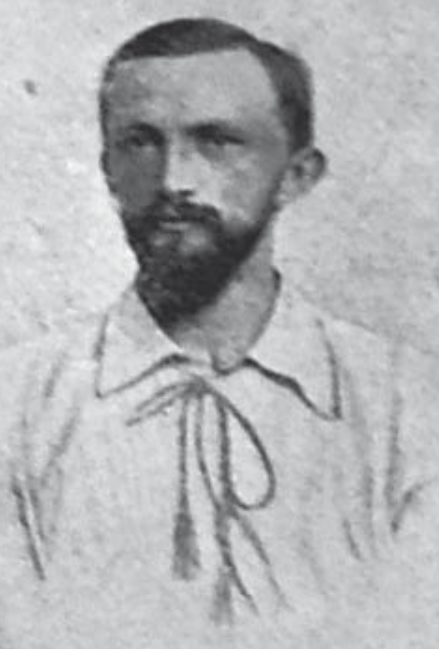
Gustav Conrau
Conrau first encountered Bangwa people at the market in Tali in August 1897 whilst he was on route either to or from the coast and Bali in the upper grasslands. Tali lay a few kilometres east of Tinto which was a German trading station. More than a year later as he was passing again through Tinto he diverted eastwards to visit the Bangwa area. He stayed in Azi from the 11th to the 15th December 1898 where he met and befriended the young Fon (king), Fontem Asonganyi. Asonganyi gave Conrau 80 men as workers for the plantations around Victoria (now Limbe). My informants cast some doubt on this number and suggest that it was much less. Those whom Asonganyi gave were described as being young men who were either troublesome or restless individuals.
About March or April of 1899 Conrau returned and stayed at Azi for five or six months until the main part of the rainy season was ending in September. Throughout all his journeys from the coast Conrau had surveyed and mapped the areas he travelled through and now from his base in Azi he continued this exercise in the surrounding area. During this second visit he also collected and catalogued specimens of the flora and fauna of the area[2]. He also procured a number of Bangwa ritual carvings which would later end up in museums and galleries in Germany, France and the USA[3].
___________________________________
1 This is based upon German records and conversations in the early 1980s with: Stanislaus Nkeng, servant to a German engineer during the German administration and translator of Henry Cadman who was the British district officer who carried out the census of 1922; Mbe Fondi, an elderly and prominent court official at the palace in Azi; and Michael Tintui, secretary to Fon Fontem Defang, Asonganyi's successor.
2 Plant specimens collected by Conrau and sent to Berlin resulted in several taxa commemorating his name including Garcinia conrauana Engl. in the Clusiaceae and Magnistipula conrauana Engl. (= Hirtella conrauana (Engl.) A.Chev.) in the Chrysobalanaceae.
Conrau also 'discovered' the Bangwa Forest-warbler (Bradypterus bangwaensis) a small bird which favours dense undergrowth and which is found only in the lower Bangwa area. Because of deforestation it is now on the endangered species list.
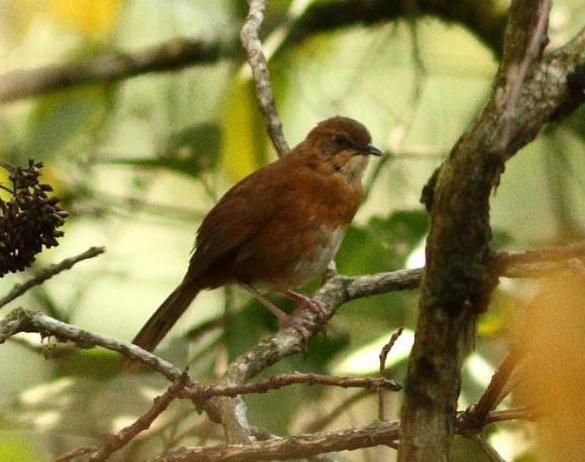
Bangwa Forest-warbler (Bradypterus bangwaensis)
3 The most famous of these is the Bangwa Queen now on display in the Musée Dapper, Paris. From German records it would seem that Conrau acquired this piece during his first journey to Azi in 1898.
___________________________________
Conrau left Azi somewhere around September/October 1989 and travelled to the coast. He returned for a third time to Azi in late October/early November 1899 with a few servants in search of more labourers. The Bangwa population resisted his request for more labourers as none of the previous consignment had returned and word had begun to spread about the conditions on the plantations and the harsh treatment meted out by the German authorities there. Asonganyi, therefore, declined Conrau's request. After an abortive attempt to get to Dschang, Conrau found himself stranded in Azi amid a population who were less and less enthusiastic about his presence. My informants [1] insisted that he was not held as a 'prisoner' as some reports claimed, including a note written by Conrau himself. His bearers had long since returned to the German garrison near Tinto and he was left with a few servants who grew increasingly nervous about the Bangwa's animosity. His Bali translator falsely informed Conrau of plots to kill him and it was this which led to Conrau's rather hysterical flight in the night and suicide in mid to late December 1899.[4] . The spot where he died was by the river directly beneath where the Catholic mission church at Belleh now stands. Conrau's skull and one of his hands were removed from his body and the remains were buried in the sacred forest, the Lefem, near to the Fon's palace. What became of his skull is uncertain but I did hear claims that it was kept in the Fon's palace in Azi up until the 1950s.
___________________________________
4 See Die Kamerun-Sammlungen von Gustav Conrau im Ethnologischen Museum Berlin. Figuren der Bangwa (Grasland) sowie der Balong, Barombi und Banyang (Waldland). In: Kunst & Kontext N°9/2015. This article draws upon letters and reports written by Conrau and contemporary German colonial records.
Gustav Conrau in 'Fontem'
2nd visit: March/April 1899 till September 1899
3rd visit: Late October/early November 1899 till his death in mid December 1899
Conrau made a number of maps and detailed notes about the terrain on route from the coast to the grasslands including the route from Tinto to Fontem. To get to the grassland highland plateau the Germans would use either a path going north from Tinto or a path going north-east through modern-day Sabes (designated on the map as "Sabe") in the north of the Mundani country to reach Bali and Dschang. Conrau's notes and drawing were sent to Germany and detailed maps produced. The above image shows the area around Azi, which is named as "G. Conrau's Bangwa St[ation]". Clicking on it will take you to his detailed map of the route from Tinto in the west to Azi in the east.
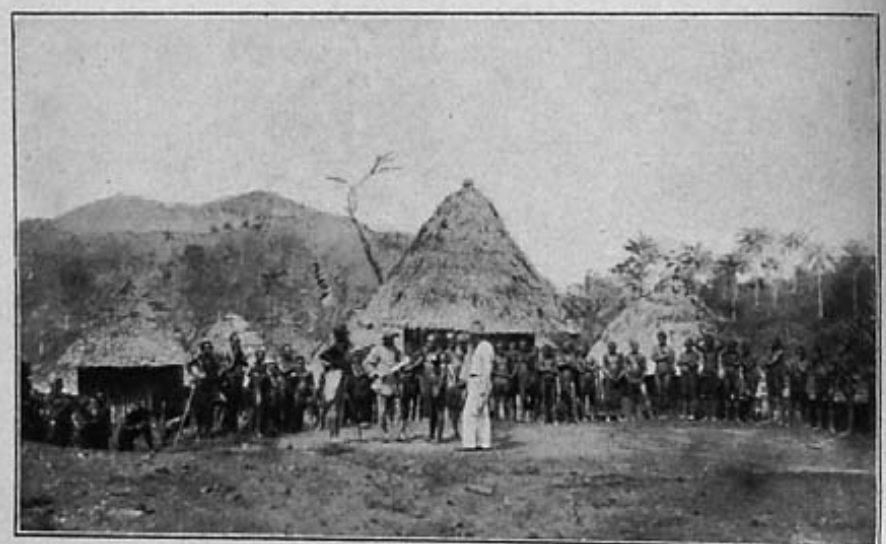
German traders in the Market in Azi - Fontemdorf
1901
Following the news of Conrau's death, German troops under the command of Hptm. von Besser advanced on the Bangwa area from Tinto in late February 1900 and met stiff resistance at Fossungwenchen on the banks of the River Bago. Traces of the Bangwa ramparts can still be seen to this day. About 30 Bangwa were killed in the fighting and some hours later the German force reached Azi which it found abandoned as the population, including the Fon, Fontem Asonganyi, had escaped into the forest.
A second and larger punitive expedition led by Schutztruppe commander von Pavel travelled from Tinto and began its attack on the Bangwa country on the 11th November 1901. The force split into two contingents at the village of Takwai just west of Fossungwenchen. The first group, led by von Pavel, attacked across the ford at Fossungwenchen and made directly towards Azi. The other went northwards along the river Bago to enter the Bangwa lands at Lower Foto in the north west to make a flanking manoeuvre down through Lewoh (Fotabong I) and reached Azi a few days later.[5]
_________________________________
5 A fuller account of these events can be found in the article The Bangwa and the Germans: A Tailpiece on this website. That article says that the second force attacked from "Foto". These troops passed through Ndumbin in the lower forest area of Foto Ndungatet, a kingdom to the north of Lebang. (See map above) Mbe Forbinake refers to this in his interview (see Audio file on this website) and Mbe Sylvester Among, catechist at Fotabong, confirmed this in a fuller account of the German presence in Lewoh (Fotabong I).
The people of Lebang often claim that they were betrayed to the Germans by the people of Lewoh. This account has been exaggerated over the years. The people of Lewoh and Lebang were in a state of utter terror and all of them fled to the bush as the Germans approached. The Fon of Lewoh at the time, Achankeng, was elderly and remained in his palace in the hope of discussing arrangements for peace. The Germans had no need for or interest in support from Lewoh. However, despite their military prowess they became lost and had to coerce one Lewoh man to eventually show them the way to Azi. The sight of the Germans being led into Azi by a Lewoh man is perhaps the origin of this grievance and over the years the 'betrayal' has been exaggerated.
_____________________________________
Asonganyi continued to hide in the forest and eventually settled in a cave in the area of Mbindia several kilometres north-east of Azi. From there it is said that he conducted a sporadic guerrilla war against the Germans but the extent of his activities is open to question as he and his followers were armed only with swords, spears and ancient Dane guns (early 19th century long-barrelled flintlock muskets). They were certainly no match for modern German rifles and machine guns. The Germans installed one of Asonganyi's sons, Ajongakoh, as a puppet ruler. Asonganyi was eventually captured in 1911 after being betrayed by a man from Essoh Attah (Foreke Cha-Cha) who had quarrelled with him over a woman. Asonganyi was then sent into exile in Garoua in the far north of Kamerun. When Asonganyi was reinstated as Fon by the British after the defeat of the Germans in Kamerun in 1914, Ajongakoh left for Mamfe, a Bayang town 80km to the west, where he died in poverty in the 1930s.
Several months after the defeat of the Bangwa in November 1901 Hauptmann (Lieutenant) Emil Rausch
the Germans maintained a small military force in Azi but on the 4th April 1903 the military garrison at Tinto was moved to Azi which the Germans renamed 'Fontemdorf'.
January 1902 - Von Pavel - 2,000 labourers as compensation
